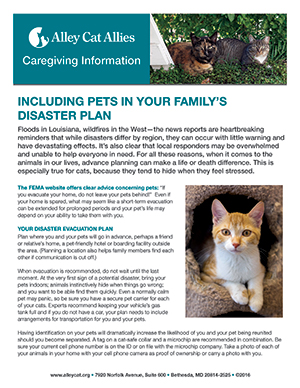Floods in Louisiana, wildfires in the Westthe news reports are heartbreaking reminders that natural disasters can occur with little warning, and have devastating effects. Local responders may be overwhelmed and unable to help everyone in need. This is why when it comes to the animals in our lives, advance planning can be the difference between life and death. This is especially true for cats, because they tend to hide when they feel stressed.
The FEMA website offers clear advice concerning pets: “If you evacuate your home, do not leave your pets behind!” Even if your home is spared, what may seem like a short-term evacuation can be extended for prolonged periods. Your pet’s life may depend on your ability to take them with you.
Your Disaster Evacuation Plan
Plan where you and your pets will go in advance. Some options are a relative or friend’s home friend or relative’s home, a pet-friendly hotel or boarding facility outside the area. (Planning a location also helps family members find each other if communication is cut off.)
When evacuation is recommended, do not wait until the last moment. At the very first sign of a potential disaster, bring your pets indoors. Animals instinctively hide when things go wrong; and you want to be able find them quickly. Even a normally calm pet may panic, so be sure you have a secure pet carrier for each of your cats. Experts recommend keeping your vehicle’s gas tank full. If you do not have a car, your plan needs to include arrangements for transportation for you and your pets.
Having identification on your pets will dramatically increase the likelihood of you and your pet being reunited if you are separated. A tag on a cat-safe collar and a microchip are recommended in combination. Be sure your current cell phone number is on the ID or on file with the microchip company. Take a photo of each of your animals in your home with your cell phone camera as proof of ownership, or carry a photo with you.
Your Pet Evacuation Kit
Pack extra pet care items in an easy-to-grab kit, including:
- Pet food and bottles of water (at least five-day supply)
- Medications
- Cat litter/pan
- Food/water dishes (spill proof)
- Blankets and toys
- Paper towels and plastic bags for clean-up
- Collars and tags for each pet, leashes for dogs, harnesses for cats
- Handling gloves for cats and muzzles for dog (in case others need to help with your pets)
- Cage/carrier, one for each animal, labeled with your contact information
- Vaccination/veterinary records, photos, and descriptions of each of your pets in a waterproof zip-lock bag
What if Disaster Strikes When You’re Not Home?
Place stickers on the doors to your home to notify rescue personnel that animals are present, and where they can find your evacuation kit. Keep a current list of your pets and where they most often hide, along with your contact information to assist rescuers and save precious time.
You can also enlist a willing and trusted neighbor to assist your pets in case you are not home. This person should be familiar with your animals and have a key to your home. You might want to consider a Neighborhood disaster plan.
Creating a Neighborhood Disaster Plan
Working with neighbors and local animal welfare organizations, you can create a buddy system to rescue pets when a neighbor is not home, and to assist senior citizens and their pets. Share your neighborhood plan with local emergency management officials to be sure that they will support your plan in the event of a disaster. There are lots of helpful resources online to get you started.
Having a plan to safely evacuate all of your family members, including your pets, will give you peace of mind and help ensure that everyone will be safe no matter what happens.


